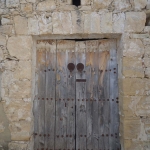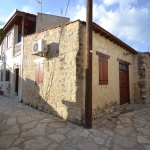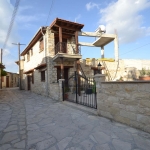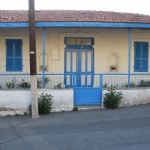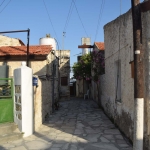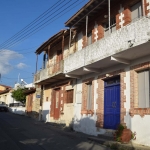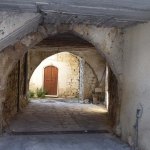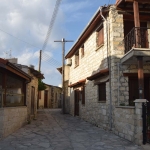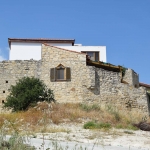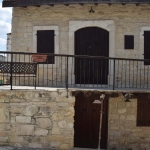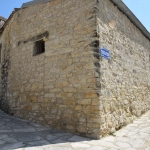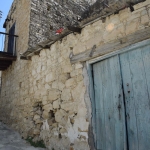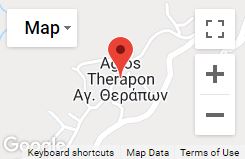Agios Therapontas, a small picturesque village built on the Troodos mountain region, emerges predominately and proudly for centuries.
It is a village of the Lemesos District, on an altitude of 640 metres and it is subsumed in the geographical region of Krasochoria.
Our village in the past
During the Frankish period, our village was owned by a feudal lord, though, as it seems, it existed since the Byzantine years. More specifically, in 1941, according to Mas Latri, the village was a fief of Petros Podokatoros. However, as Karouzis remarks, “judging by the toponym of the village and the holy water of Agios Therapontas, we may have to conclude that Leontios Machairas’ reference to Alamanos Agios Therapontas, who was a pillar saint in the village of Koilani, may be related to the village of Agios Therapontas, a fact which gives us grounds to consider the village of at least Byzantine origin”.
Naming
The village was named after Agios Therapontas, who according to tradition was a pillar saint at the place where the holy water and the church of Agios Therapontas are today. This is also confirmed by Karouzis’ aforementioned observation.
We also cite the tradition narrated to us by the priest of the village.
Traditional neighbourhoods
In a unique landscape with rich natural vegetation “emerges” a settlement with a very interesting architecture. Most of the roads are still covered with chesil stones, whereas some of them, mainly in the periphery of the settlement, have been paved with slabs. Attention is particularly drawn by the approximately twelve traditional buildings called “votes”. Karouzis describes “votes” as “a kind of original building, which is the ground floor of a house and which is only found in few villages of Cyprus. It is an arched covered room, mainly used for storing large clay jars containing wine or even used as a stable for animals. Above the ground floor arch, which is built with local stone, an upper floor is built in order to accommodate the owners”.
The village of viticulture
Agios Therapontas is undoubtedly the village of viticulture. From the very ancient years up until today, the residents of the village mainly dealt with viticulture. Moreover, according to the records of 1971, approximately 2.336 ‘skales’ of land (one ‘skala’ equals to 1337.8 square metres) were cultivated with vineyards. What is noteworthy is the fact that even today vineyards continue to occupy an important part of the cultivating land. Viticulture is favoured both by the compilation of the ground as well as by the climatic conditions of the area. The Great Cyprus Encyclopaedia underlines that “the dismembered landscape of the woads, with the mild circular hills, as well as the relatively medium average rainfall of approximately 600 mm, contributed to the expansion of vineyards and especially the ones which could produce wine”.
Traditionally, the main breed was the local black grape followed by the breeds of ‘soultanini’, ‘malagas’ and ‘cardinalios’. Nowadays, as Karouzis remarks, “new breeds, which seem to be more productive, have begun to be cultivated”.
Apart from the cultivation of vineyards, in the village thrive, although in a more limited extent, fruit-baring trees such as olive trees and carob trees, citrus fruits and vegetables.
Population
The village has experienced both increases and decreases of the population. From 1881 until 1946, the population of Agios Therapontas increased significantly. However, later on, a gradual decrease of the population began. This fact is owed, as the Great Cyprus Encyclopaedia observes, “to the relatively small average size of estates, to the mechanization of agriculture and to the absence of non-agricultural job positions, either in the village or in the neighbouring settlements”. A presentation of the course of the population of Agios Therapontas from 1881 until 2001 is cited below.
| Year | Number of Residents |
| 1881 | 243 |
| 1946 | 530 |
| 1982 | 302 |
| 2001 | 152 |
What is also noteworthy is the fact that the Community Council’s aspiration is to intercept the decreasing course of the population number with a series of developmental projects. Moreover, Karouzis remarks that: “Despite the scalping the village has experienced and is still experiencing, the remaining residents take care of the beautification of the village with works such as the traditional fountain, tile grounds and tree plantations along the road which leads to the village”.
Sources:
“Diadromes sto parelthon, orama sto mellon, Europaikes Imeres Klironomias, Kypros 2004 (“A route in the past, a vision to the future, European Days of Heritage, Cyprus 2004”)
Great Cyprus Encyclopaedia, vol.3
